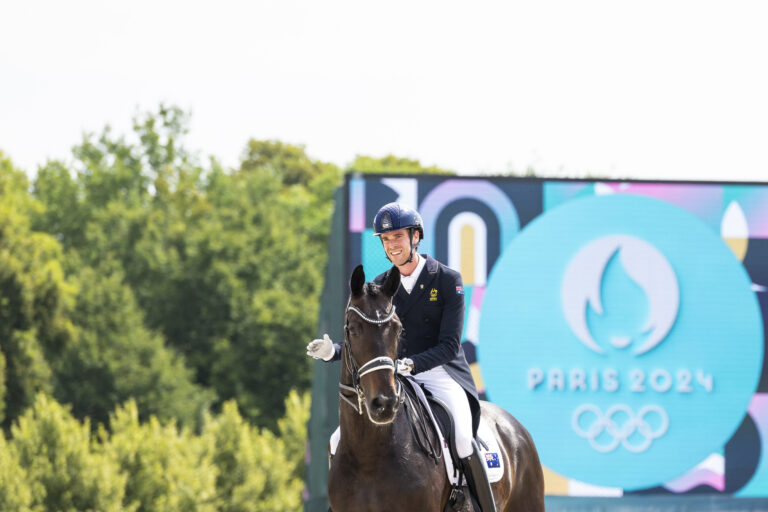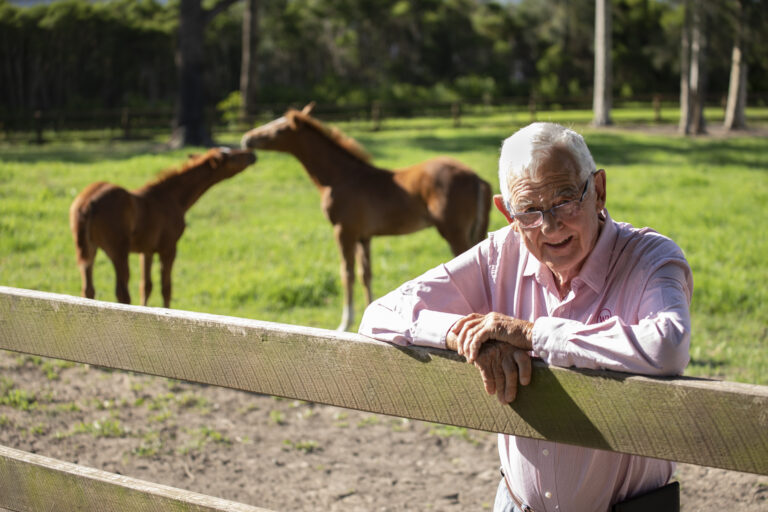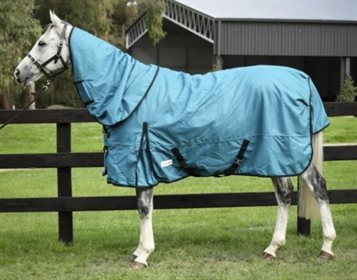This article has appeared previously with Equestrian Life. To see what’s in the current issue, please click here
© Stefano Grasso/LGCT
Are martingales and other training aids an asset or a liability when it comes to the daily training routine? Three professional riders from three disciplines take us through the pros and cons.
EVENTING
AMANDA ROSS
I USE A MARTINGALE on horses that might try to run through the hand and throw their heads when jumping. However, all my initial training is done without a martingale, as I actually find they get in the way of my corrections! I would prefer to deal with the issue through training, that is, a one-rein stop, flexing to prevent throwing the head up, and teaching better acceptance of contact, rather than put a martingale on to bandaid the issue. If I’m jumping a horse that’s sometimes inclined to run through the bridle and throw its head or be inconsistent on the contact, a martingale can help reduce how often the horse throws the head, but only after I’ve schooled the horse to understand how to yield to pressure from the bit. Otherwise they can throw the head up and hit the bit, thus making matters worse.
I would suggest it is when schooling that the horse requires the martingale first. Most people I teach use a martingale for horses that carry or throw their heads a little too high when jumping. Martingales are not a tool to teach horses to drop their heads down, they are a deterrent once the horse has been taught how to respond to rein pressure but may let anxiety get in their way at times. Whilst competing, you can’t stop, circle or school as you would at home, so martingales can work well as a management tool. I think a martingale can be a useful tool to steady the contact for riders and horses who struggle with that problem. My pet hate, though, are really short martingales used to pull horses’ heads down! Novice and experienced riders can find a martingale useful. The length needs to be appropriate, and an understanding of why it’s being used. Correct fit determines its safety and success.
Have you used any other training aids with good results?
Most of them at some stage through trial and error! I use either side reins or an elastic draw reinstall/bungee to lunge in. The elastic draw reins are great to teach sensitive souls how to round and relax their head, neck and back, whilst allowing some give, so as not to be too harsh. The side reins are super to set a specific height of contact, stop horses boring down, and form a steady contact. I also run the lunge rein through the inside bit ring and back to the inside girth buckle to help turn and supple a stiff neck.
I have used draw reins on distracted types and those with a strong neck and weak hindquarters. I like the Market Harborough or German martingale for the same reason, they are good for those not ready to hold two pairs of reins. I use these for kids to help them understand the feeling of training and maintaining roundness and a steady contact on ponies. I’m not a fan of anything I can’t release in an emergency!
The training aid you can’t live without and why?
A lunge rein and a set of side reins. Because they save my bacon when horses get wild!
DRESSAGE
MAREE TOMKINSON
WE HAVE OUR horses broken in at around three years old and straight away we put them in a martingale. For several reasons: Firstly, it is a very good “Oh Jesus strap” if the young horse gets a fright or trips. Secondly, it helps keep their head carriage steady and thirdly, it is a stabiliser for the rider as the young horse is usually unbalanced and unsure at such an early age.
Most horses do not need the martingale for very long and then we take it off. Others, however, can be more unbalanced or hot and tending to shy, and in these cases we will leave it on longer. As long as I think it is benefiting the horse and helping to guide him in the correct frame and direction.
There are a couple of other reasons I would use a martingale. If I had a horse that I thought was difficult or badly behaved I would use it to give the rider stability and extra control if needed, as it would restrict the horse from using his head and neck to pull the reins away from the rider and unbalancing them. I would also suggest a martingale to a rider who is struggling with keeping their horse’s attention and balance because of distractions around the riding arena, and maybe doesn’t not have the core stability to manage this with a steady contact.
Have you used any other training aids with good results?
We only use a normal KK training bit on all horses, with a Hanoverian noseband, not too tight, especially on the young ones. I do not use the very fat KK bit, but the smaller one, as I think it is more comfortable in their mouths and it is also what will be used later on with the double bridle. No other bits at all, it’s all about the quality of training, not the bits!
Occasionally we use running reins. There are 18 horses in the stable at the moment and only one in running reins; she is very hot and very high in front and at this point it is the best possible way to manage her… hopefully it will get easier as she gets older and more experienced.
In a perfect world we would all be perfect riders with perfect horses and never need training aids, but unfortunately we are not and sometimes it is kinder for the horse and more effective for the rider to use the help of training aids such as these. We use a saddle, bridle, boots etc. so why not a martingale if it helps?
It is not good for your horse to learn to go in the wrong way, not good for his mental or physical health, so try to start in the right way and then there will be no need to retrain later on. We also try not to use spurs for as long as possible, and then even with Grand Prix horses we take them off as often as possible. In the end they should be able to do all the Grand Prix work in a snaffle with no spurs… something to aspire to. Easier with some horses than others! Good luck!
SHOWJUMPING
ALEX ROONEY
PERSONALLY, I AM not a fan of using martingales on young horses. I use open reins to exaggerate the turning aid and I find the martingale restricts this and causes the horse to just increase the bend in its neck rather than bend through its whole body to turn. If I feel the need to use one, it will generally be in later stages of training, when I find a horse has a hollowing resistance that I cannot train, especially when the horse’s adrenalin has kicked in whilst in the ring.
My reservations on martingales whille showjumping include restricting the horse’s use of its neck, causing a hollow jump. So, for me its imperative that the martingale is not too short. I will only use a running martingale with a preference for one that is elastic. The elastic ones tend not to give such an abrupt feel on the horse’s mouth when they hit the end of the rings.
Do you use other training aids with good results?
If I am going to lunge a horse I find that a De Gouge is the most beneficial and effective for me. It encourages the horse to work over the back and lengthen its neck by applying pressure on the horse’s poll and a little on its mouth. I also really like that this piece of tack joins between the horse’s front legs, thus allowing the horse to lengthen the outside of its neck when a change in bend occurs.
Any equipment joined at the side of the horse such, as side reins, restricts the horse’s neck bend causing a hollowing of the horse’s neck and a dullness to the outside rein. However, before I introduce a horse to a De Gouge I like to get the horse comfortable with a neck stretcher or bungee. The neck stretcher will not frighten the horse when they first feel pressure on their mouths and it gives them a chance to feel the bit with a much softer approach. I prefer to use the neck stretcher for horses that are tentative to take and sit on a contact, as it allows them to get used to a soft, and more importantly, a consistent feel on their mouths. When using this type of equipment the horse must always be in front of the vertical, never be asked to carry itself behind the vertical, as this can have devastating affects. Moreover, it is imperative to get professional help when introducing this equipment to your horse. This will ensure the equipment fits correctly and the horse has an encouraging and relaxing experience.
READ THE LATEST NEWS ARTICLES HERE








